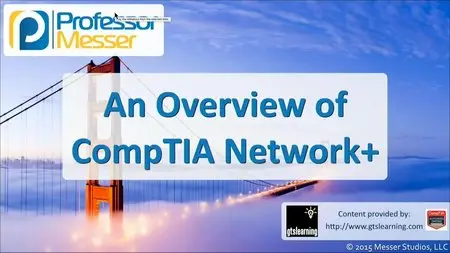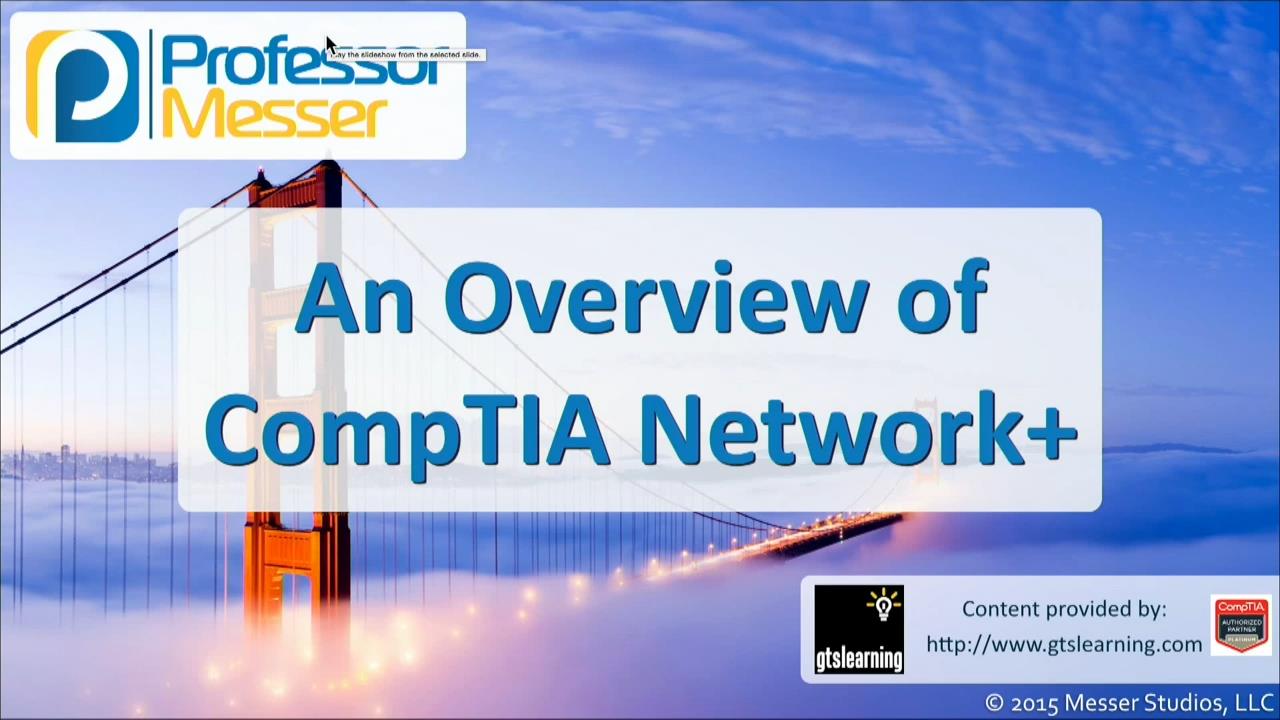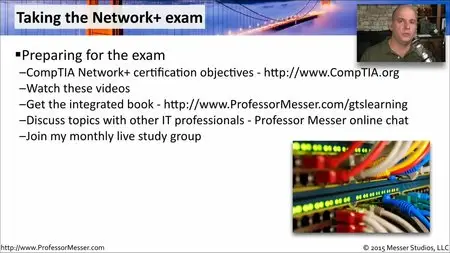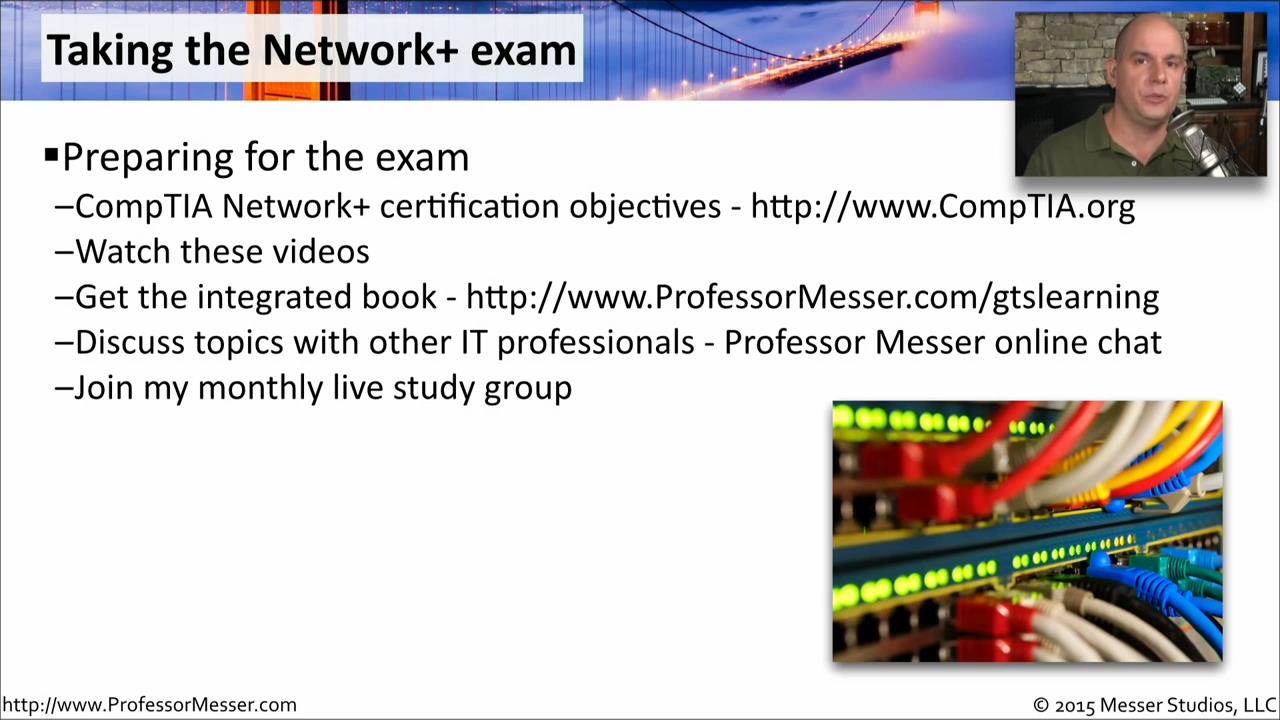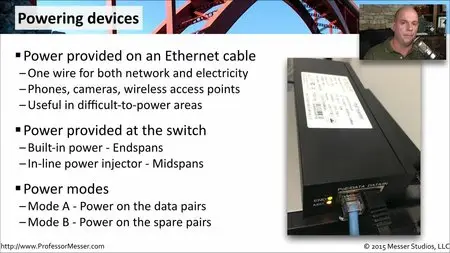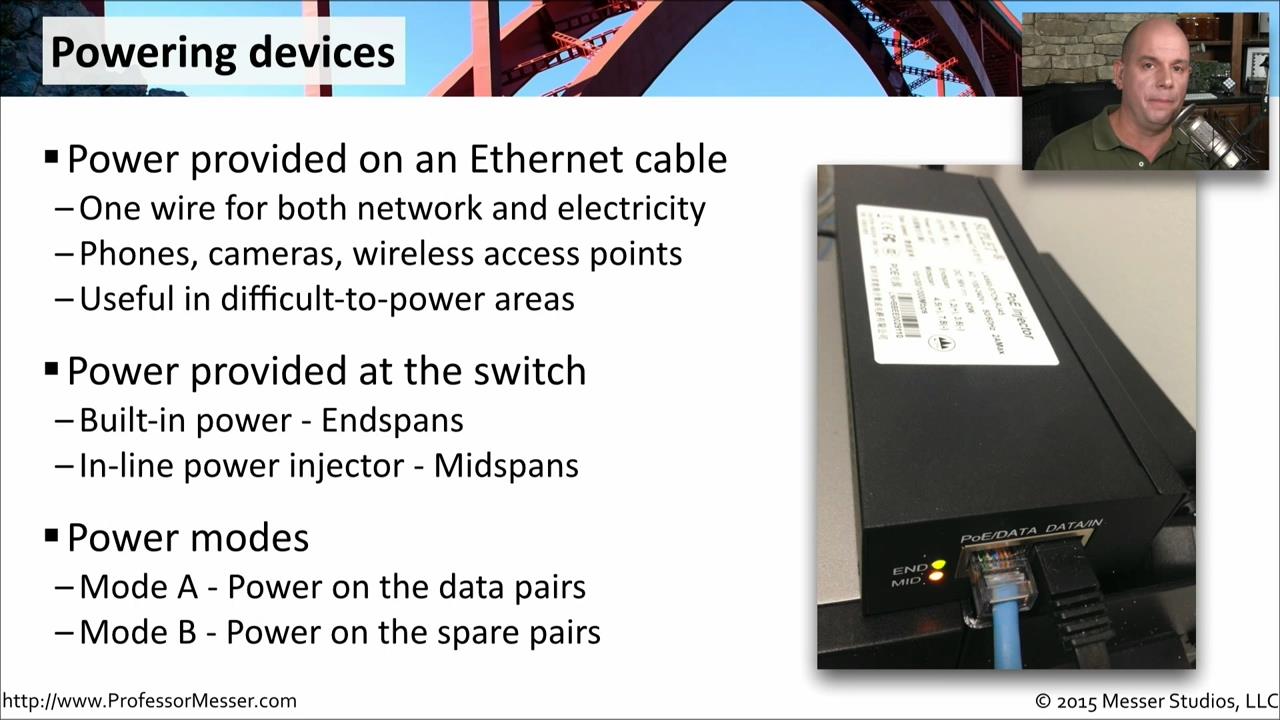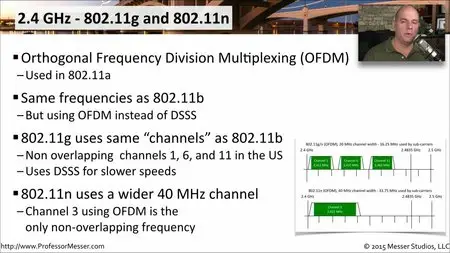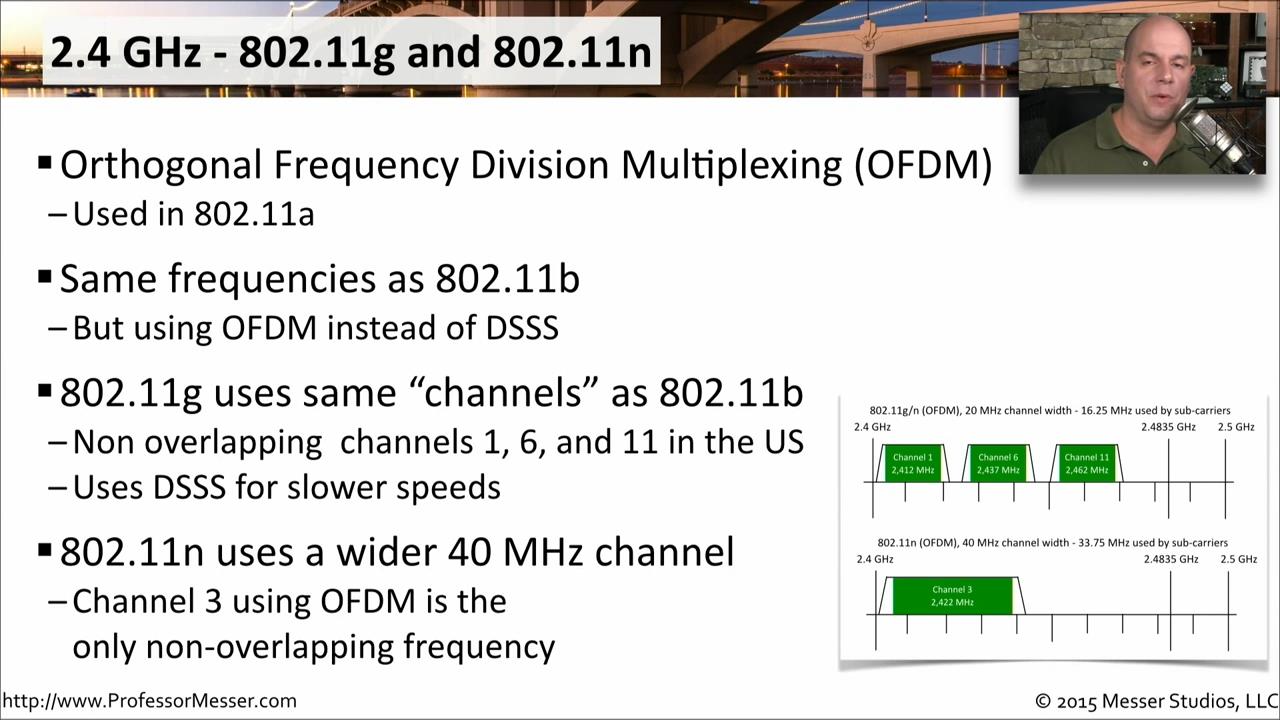Professor Messer’s CompTIA N10-006 Network+ Training Course
English | 2015 | mp4 | H264 1280x720 | AAC 2 ch | 14 hrs 53 min | 11.3 GB
eLearning
English | 2015 | mp4 | H264 1280x720 | AAC 2 ch | 14 hrs 53 min | 11.3 GB
eLearning
Contents
Section 1: Network Architecture
1.1 – Network Devices
Common Network Devices (8:53)
Intrusion Detection and Prevention Systems (5:13)
Content Filters (4:52) | Load Balancers (2:45)
Packet Shapers (2:32) | VPN Concentrators (2:50)
1.2 – Remote Access
VPN Connections (3:23) | VPN Protocols (5:44)
TACACS and RADIUS (3:54) | Remote Access Services (2:31)
Web Services (3:09) | Unified Voice Services (3:04)
Wireless LAN Controllers (2:38)
1.3 – Network Services
DHCP Addressing Overview (5:15) | DHCP Reservations (3:16)
DHCP Scopes (2:11) | DHCP Leases (4:10) | DHCP Options (2:47)
An Overview of DNS (6:29) | DNS Records (5:54) | Dynamic DNS (3:16)
Proxy Servers (3:47) | Understanding Network Address Translation (7:21)
1.4 – WAN Technologies
SONET, DWDM, and CWDM (4:11) | ATM, Frame Relay, and MPLS (4:52)
Satellite, ISDN, Cable, DSL, and Dialup (8:54) | PPP and Multilink PPP (2:30)
GSM, CDMA, and WiMAX (3:37) | Leased Lines and Metro Ethernet (4:07)
Circuit Switching and Packet Switching (3:21)
1.5 – Cable Types
Copper Connectors (8:05) | Copper Cabling (9:28)
Straight-Through, Crossover, and Rollover Cables (7:42)
Fiber Connectors (3:51) | Fiber Cables (7:37)
Media Converters (3:19) | Network Cabling Tools (8:13)
1.6 – Network Topologies
Common Network Topologies (7:15)
1.7 – Network Infrastructures
Network Infrastructures (6:20)
1.8 – Network Addressing
Binary Math (8:20) | An Overview of IPv6 (7:25)
IPv6 Address Configuration (5:40) | IPv6 Interoperability (3:09)
IPv4 Classes (8:12) | Classless Inter-Domain Routing (8:12)
IPv4 Addresses and Subnetting (17:13) | APIPA (3:35)
Unicast, Multicast, and Broadcast (3:40)
Broadcast Domains and Collision Domains (6:18)
1.9 – Routing
Routing Tables (13:58) | Route Aggregation and Distribution (5:22)
Routing Metrics (2:47) | Static and Dynamic Routing (4:48)
Link State, Distance Vector, and Hybrid Routing (3:39)
IGP and EGP (5:31) | High Availability (5:09)
1.10 – Unified Communications
Unified Communication Technologies (7:12)
1.11 – Cloud and Virtualization Technologies
Virtualization (8:30) | Storage Area Networks (7:09)
Cloud Technologies (5:22)
1.12 – Implementing Networks
Implementing a Basic Network (8:51)
Section 2: Network Operations
2.1 – Monitoring the Network
Using Protocol Analyzers (2:58) | Network Monitoring Tools (8:08)
SIEM (3:28) | Environmental Monitoring Tools (2:20)
Wireless Tools (3:37)
2.2 – Metrics and Reporting
Baselines and Bottlenecks (7:32) | Log Management and Graphing (5:32)
Utilization Statistics (5:57) | Interface Monitoring (4:48)
2.3 – Configuration Management
Configuration Management (4:51)
On-Boarding and Off-Boarding Mobile Devices (7:13)
Network Access Control (4:41) | Documenting the Network (7:38)
2.4 – Network Segmentation
Segmenting the Network (5:17)
2.5 – Patches and Updates
Patches and Updates (5:51)
2.6 – Switch Configuration
Configuring VLANs (7:11) | Spanning Tree Protocol (7:06)
Switch Interface Configuration (4:23) | Power Over Ethernet (3:04)
Switch Management (5:01)
2.7 – Wireless Networks
Wireless Network Devices (5:47) | Wireless Connections (11:05)
Wireless Antenna Technologies (4:13) | Using Wireless Networks (3:42)
Section 3: Network Security
3.1 – Risk
Business Risk (8:52) | Single Point of Failure (2:45)
Vulnerability Scanning (6:31) | Penetration Testing (5:41)
3.2 – Vulnerabilities and Threats
Denial of Service (8:55) | Wireless Network Attacks (8:13)
Wireless Protocol Attacks (7:37) | Brute Force Attacks (6:04)
Session Hijacking (5:11) | Social Engineering (5:14)
Man in the Middle Attacks (4:05) | VLAN Hopping (5:47)
Compromised Systems (4:19) | Insider Threats (4:05)
Zero-Day Attacks (4:12) | Operating System Vulnerabilities (10:57)
3.3 – Network Hardening
Anti-Malware Software (4:23) | Switch Port Security (5:17)
Security Policies (2:00) | Disabling Unneeded Services (4:03)
Using Secure Protocols (4:18) | Access Lists (5:43)
Wireless Security (5:48) | User Authentication (8:44)
Hashing (4:17)
3.4 – Physical Security Controls
Physical Security Controls (5:55)
3.5 – Firewalls
Firewalls (6:52) | Firewall Configurations (6:35)
3.6 – Network Access Control
Network Access Control Models (5:03)
3.7 – Forensics
Basic Forensic Concepts (5:03)
Section 4: Troubleshooting
4.1 – Network Troubleshooting Methodology
Network Troubleshooting Methodology (5:59)
4.2 – Troubleshooting Tools
Command Line Tools (19:47) | Physical Testing Tools (4:09)
Web-based Troubleshooting Tools (3:25) | Protocol Analyzers (2:36)
4.3 – Wireless Issues
Troubleshooting Wireless Signals (6:03) | Troubleshooting Wireless Configurations (6:54)
4.4 – Copper Cable Issues
Troubleshooting Copper Cables (6:19) | Troubleshooting Signal Loss (6:15)
Troubleshooting Network Cabling (4:27)
4.5 – Fiber Issues
Troubleshooting Fiber Issues (5:11)
4.6 – Network Issues
Troubleshooting IP Configurations (4:46)
Troubleshooting DNS and DHCP (3:44)
Troubleshooting Broadcast Storms and Switching Loops (4:30)
Troubleshooting Interface Configurations (4:12)
Troubleshooting VLAN Assignments (2:53)
Troubleshooting Network Connectivity (5:22)
Troubleshooting Mismatched MTUs (4:28)
Troubleshooting NIC Teaming (2:48)
4.7 – Security Issues
Troubleshooting Firewall Security Issues (4:34)
Troubleshooting Operating System Security Issues (6:18)
Troubleshooting Denial of Service (4:34)
Troubleshooting ICMP and ARP Issues (3:28)
Troubleshooting Malicious User Activities (3:14)
Troubleshooting Authentication Issues (4:59)
4.8 – WAN Issues
Troubleshooting WAN Interfaces (4:03)
Troubleshooting Customer Premise Equipment (5:21)
Company Security Policies (3:08)
Section 5: Industry Standards, Practices, and Network Theory
5.1 – The OSI Model
Understanding the OSI Model (8:29)
5.2 – Network Theory and Concepts
Network Fundamentals (6:19) | Modulation Techniques (3:05)
Hexadecimal Math (5:48) | Octal Math (3:25)
CSMA/CD and CSMA/CA (2:36) | The TCP/IP Suite (2:27)
5.3 – Wireless Network Standards
802.11 Wireless Standards (6:12)
5.4 – Wired Network Standards
Ethernet Standards (7:46)
5.5 – Policies and Procedures
Security and Network Policies (3:26)
5.6 – Safety Practices
Safety Practices (4:31) | Understanding Electrostatic Discharge (3:00)
Emergency Procedures (2:53)
5.7 – Installation and Configuration
MDF and IDF (2:54) | Cable and Power Management (3:45)
Rack Systems (3:45) | Labeling and Documentation (3:57)
5.8 – Change Management
Change Management Procedures (3:37)
5.9 – Network Ports and Protocols
Common TCP and UDP Ports (10:58)
5.10 – Application Ports and Protocols
Application Ports and Protocols (6:53)
Screenshots:




